Knowledge and Attitudes towards Handling Eggs in the Home: An Unexplored Food Safety Issue?
Abstract
:1. Introduction
2. Materials and Methods
2.1. Design
2.2. Statistical Analysis
3. Results
3.1. Participants
3.2. Egg Consumer Preferences
3.3. Food Safety Knowledge
4. Discussion
5. Conclusions
Supplementary Materials
Author Contributions
Conflicts of Interest
References
- Havelaar, A.H.; Kirk, M.D.; Torgerson, P.R.; Gibb, H.J.; Hald, T.; Lake, R.J.; Praet, N.; Bellinger, D.C.; de Silva, N.R.; Gargouri, N. World Health Organization global estimates and regional comparisons of the burden of foodborne disease in 2010. PLoS Med. 2015, 12, e1001923. [Google Scholar] [CrossRef] [PubMed]
- Kirk, M.D.; Pires, S.M.; Black, R.E.; Caipo, M.; Crump, J.A.; Devleesschauwer, B.; Döpfer, D.; Fazil, A.; Fischer-Walker, C.L.; Hald, T. World Health Organization estimates of the global and regional disease burden of 22 foodborne bacterial, protozoal, and viral diseases, 2010: A data synthesis. PLoS Med. 2015, 12, e1001921. [Google Scholar] [CrossRef] [PubMed]
- Kirk, M.; Ford, L.; Glass, K.; Hall, G. Foodborne illness, Australia, circa 2000 and circa 2010. Emerg. Infect. Dis. 2014, 20, 1857–1864. [Google Scholar] [CrossRef] [PubMed]
- Galiş, A.M.; Marcq, C.; Marlier, D.; Portetelle, D.; Van, I.; Beckers, Y.; Théwis, A. Control of Salmonella contamination of shell eggs—Preharvest and postharvest methods: A review. Compr. Rev. Food Sci. Food Saf. 2013, 12, 155–182. [Google Scholar] [CrossRef]
- Majowicz, S.E.; Musto, J.; Scallan, E.; Angulo, F.J.; Kirk, M.; O’Brien, S.J.; Jones, T.F.; Fazil, A.; Hoekstra, R.M. The global burden of nontyphoidal Salmonella gastroenteritis. Clin. Infect. Dis. 2010, 50, 882–889. [Google Scholar] [CrossRef] [PubMed]
- Department of Health, Australia’s National Notifiable Diseases Surveillance System (NNDSS). National Notifiable Diseases Surveillance System Data. In Commonwealth of Australia: Canberra 2016. Available online: http://www9.health.gov.au/cda/source/cda-index.cfm (accessed on 1 March 2016).
- Howard, Z.R.; O’Bryan, C.A.; Crandall, P.G.; Ricke, S.C. Salmonella Enteritidis in shell eggs: Current issues and prospects for control. Food Res. Int. 2012, 45, 755–764. [Google Scholar] [CrossRef]
- OzFoodNet Working Group. Monitoring the incidence and causes of diseases potentially transmitted by food in Australia: Annual report of the ozfoodnet network, 2011. Commun. Dis. Intell. Q. Rep. 2015, 39, E236. [Google Scholar]
- Moffatt, C.R.; Musto, J.; Pingault, N.; Miller, M.; Stafford, R.; Gregory, J.; Polkinghorne, B.G.; Kirk, M.D. Salmonella Typhimurium and outbreaks of egg-associated disease in Australia, 2001 to 2011. Foodborne Pathog. Dis. 2016, 13, 379–385. [Google Scholar] [CrossRef] [PubMed]
- Chousalkar, K.K.; Sexton, M.; McWhorter, A.; Hewson, K.; Martin, G.; Shadbolt, C.; Goldsmith, P. Salmonella Typhimurium in the Australian egg industry: Multidisciplinary approach to addressing the public health challenge and future directions. Crit. Rev. Food Sci. Nutr. 2015. [Google Scholar] [CrossRef] [PubMed]
- Whiley, H.; Ross, K. Salmonella and eggs: From production to plate. Int. J. Environ. Res. Public Health 2015, 12, 2543–2556. [Google Scholar] [CrossRef] [PubMed]
- Whiley, A.; Fallowfield, H.; Ross, K.; McEvoy, V.; Whiley, H. Higher storage temperature causes greater Salmonella enterica serovar Typhimurium internal penetration of artificially contaminated, commercially available, washed free range eggs. J. Food Prot. 2016, 79, 1247–1251. [Google Scholar] [CrossRef] [PubMed]
- Okamura, M.; Kamijima, Y.; Miyamoto, T.; Tani, H.; Sasai, K.; Baba, E. Differences among six Salmonella serovars in abilities to colonize reproductive organs and to contaminate eggs in laying hens. Avian Dis. 2001, 45, 61–69. [Google Scholar] [CrossRef] [PubMed]
- Carrique-Mas, J.; Breslin, M.; Snow, L.; McLaren, I.; Sayers, A.; Davies, R. Persistence and clearance of different Salmonella serovars in buildings housing laying hens. Epidemiol. Infect. 2009, 137, 837–846. [Google Scholar] [CrossRef] [PubMed]
- Redmond, E.C.; Griffith, C.J. Consumer food handling in the home: A review of food safety studies. J. Food Prot. 2003, 66, 130–161. [Google Scholar] [CrossRef] [PubMed]
- Byrd-Bredbenner, C.; Berning, J.; Martin-Biggers, J.; Quick, V. Food safety in home kitchens: A synthesis of the literature. Int. J. Environ. Res. Public Health 2013, 10, 4060–4085. [Google Scholar] [CrossRef] [PubMed]
- Gould, L.H.; Walsh, K.A.; Vieira, A.R.; Herman, K.; Williams, I.T.; Hall, A.J.; Cole, D. Surveillance for foodborne disease outbreaks—United States, 1998–2008. Morb. Mortal. Wkly. Rep. 2013, 62, 1–34. [Google Scholar]
- Byrd-Bredbenner, C.; Maurer, J.; Wheatley, V.; Schaffner, D.; Bruhn, C.; Blalock, L. Food safety self-reported behaviors and cognitions of young adults: Results of a national study. J. Food Prot. 2007, 70, 1917–1926. [Google Scholar] [CrossRef] [PubMed]
- Brewer, M.S.; Rojas, M. Consumer attitudes toward issues in food safety. J. Food Saf. 2008, 28, 1–22. [Google Scholar] [CrossRef]
- De Jong, A.; Verhoeff-Bakkenes, L.; Nauta, M.; De Jonge, R. Cross-contamination in the kitchen: Effect of hygiene measures. J. Appl. Microbiol. 2008, 105, 615–624. [Google Scholar] [CrossRef] [PubMed]
- Klontz, K.C.; Timbo, B.; Fein, S.; Levy, A. Prevalence of selected food consumption and preparation behaviors associated with increased risks of food-borne disease. J. Food Prot. 1995, 58, 927–930. [Google Scholar] [CrossRef]
- Lu, Y. Consumer Preference for Eggs from Enhanced Animal Welfare Production System: A Stated Choice Analysis. Masters’ Thesis, University of Guelph, Guelph, ON, Canada, 2013. [Google Scholar]
- Lievonen, S.; Havulinna, A.; Maijala, R. Egg consumption patterns and salmonella risk in Finland. J. Food Prot. 2004, 67, 2416–2423. [Google Scholar] [CrossRef] [PubMed]
- Food Standards Australia New Zealand (FSANZ). Standard 2.2.2—Eggs and egg products. In Food Standards Code; FSANZ: Canberra, Australia, 2016. [Google Scholar]
- Gole, V.C.; Chousalkar, K.K.; Roberts, J.R.; Sexton, M.; May, D.; Tan, J.; Kiermeier, A. Effect of egg washing and correlation between eggshell characteristics and egg penetration by various Salmonella Typhimurium strains. PLoS ONE 2014, 9, e90987. [Google Scholar] [CrossRef] [PubMed]
- Pollock, S.; Stephen, C.; Skuridina, N.; Kosatsky, T. Raising chickens in city backyards: The public health role. J. Community Health 2012, 37, 734–742. [Google Scholar] [CrossRef] [PubMed]
- Beam, A.; Garber, L.; Sakugawa, J.; Kopral, C. Salmonella awareness and related management practices in U.S. Urban backyard chicken flocks. Prev. Vet. Med. 2013, 110, 481–488. [Google Scholar] [CrossRef] [PubMed]
- Wachinger, G.; Renn, O.; Begg, C.; Kuhlicke, C. The risk perception paradox—Implications for governance and communication of natural hazards. Risk Anal. 2013, 33, 1049–1065. [Google Scholar] [CrossRef] [PubMed]
- Redmond, E.C.; Griffith, C.J. Consumer attitudes and perceptions towards microbial food safety in the domestic kitchen. J. Food Saf. 2004, 24, 169–194. [Google Scholar] [CrossRef]
- Garbutt, C.; Simmons, G.; Patrick, D.; Miller, T. The public hand hygiene practices of New Zealanders: A national survey. N. Z. Med. J. 2007, 120, 1265. [Google Scholar]
- Van de Mortel, T.; Bourke, R.; McLoughlin, J.; Nonu, M.; Reis, M. Gender influences handwashing rates in the critical care unit. Am. J. Infect. Control 2001, 29, 395–399. [Google Scholar] [CrossRef] [PubMed]
- Jeong, J.S.; Choi, J.K.; Jeong, I.S.; Paek, K.R.; In, H.K.; Park, K.D. A nationwide survey on the hand washing behavior and awareness. J. Prev. Med. Public Health 2007, 40, 197–204. [Google Scholar] [CrossRef] [PubMed]
- Altekruse, S.F.; Street, D.A.; Fein, S.B.; Levy, A.S. Consumer knowledge of foodborne microbial hazards and food-handling practices. J. Food Prot. 1996, 59, 287–294. [Google Scholar] [CrossRef] [PubMed]
- Martelli, F.; Davies, R.H. Salmonella serovars isolated from table eggs: An overview. Food Res. Int. 2012, 45, 745–754. [Google Scholar] [CrossRef]
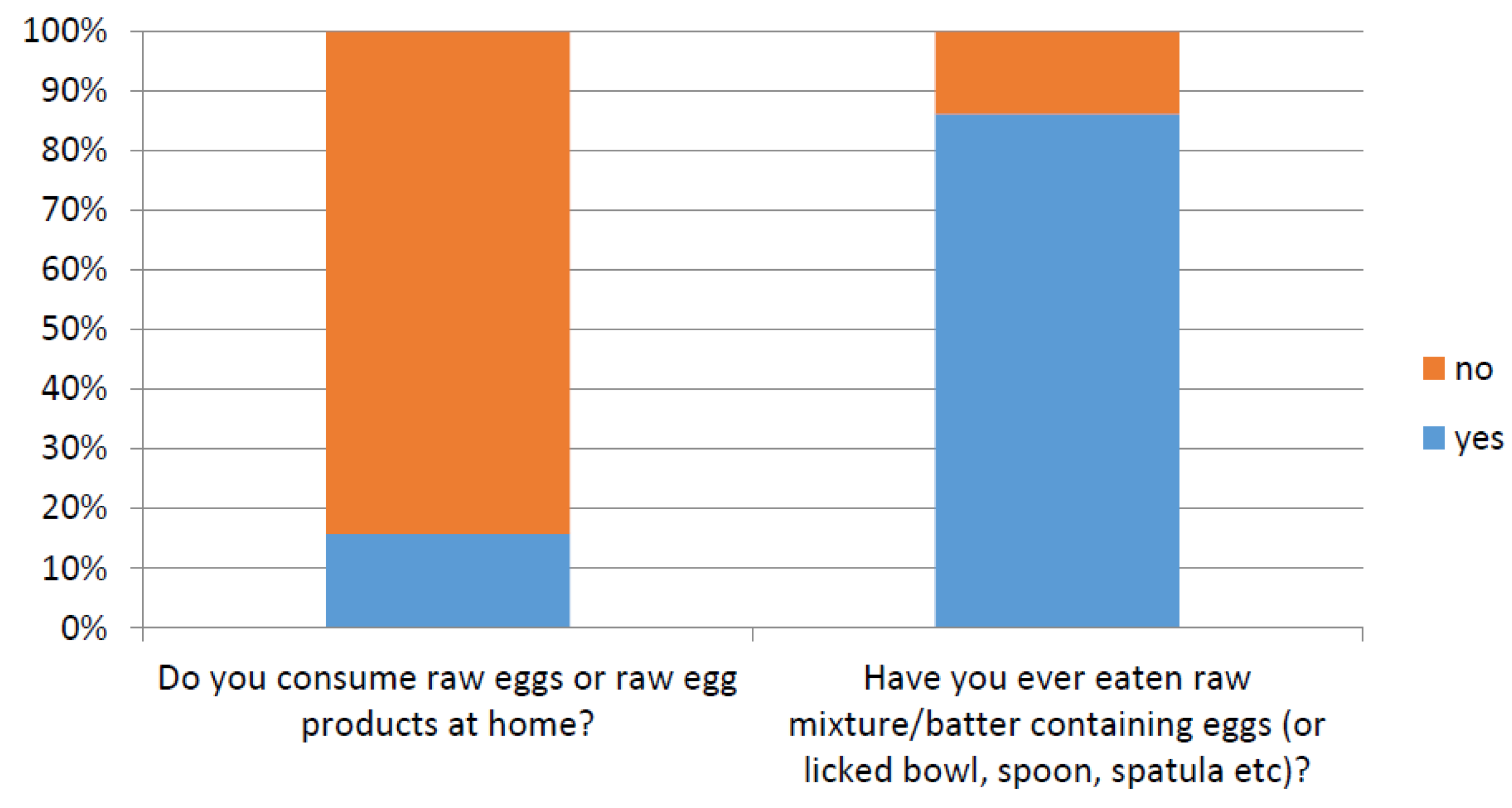
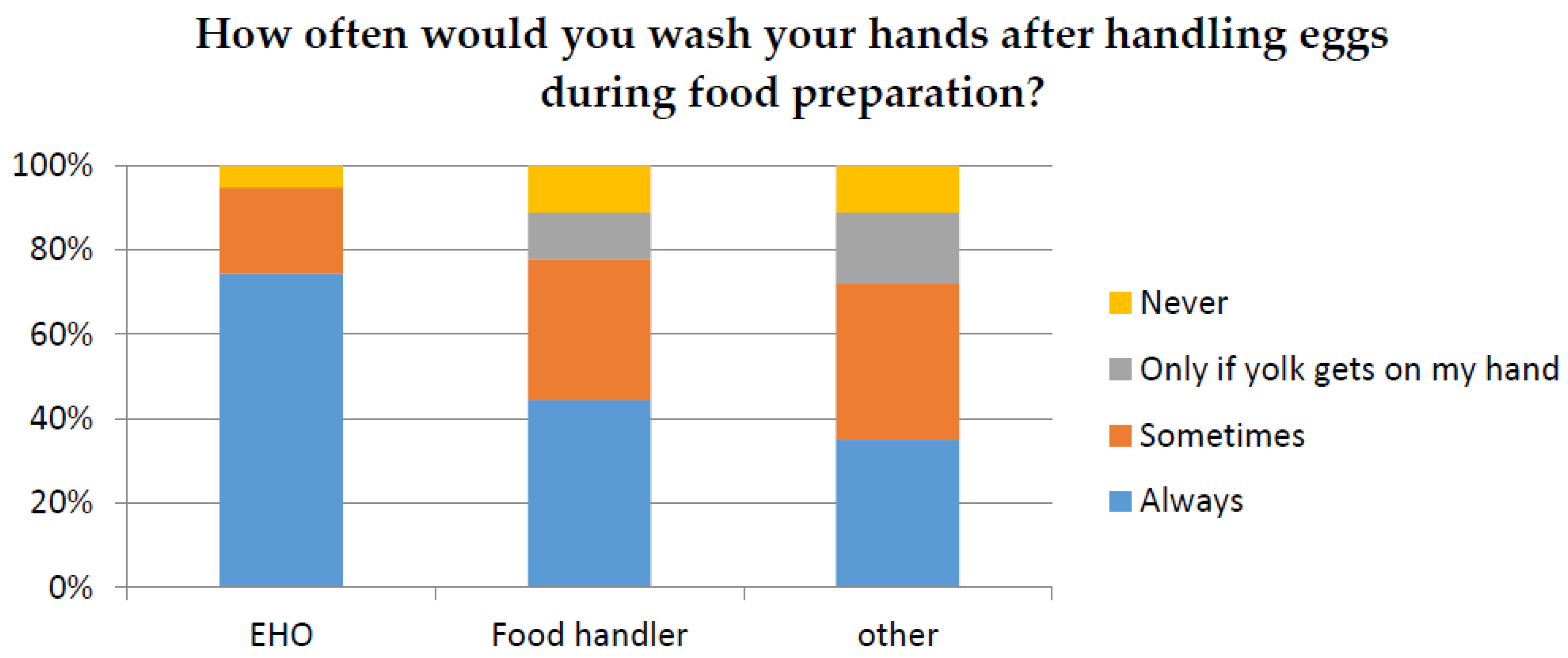
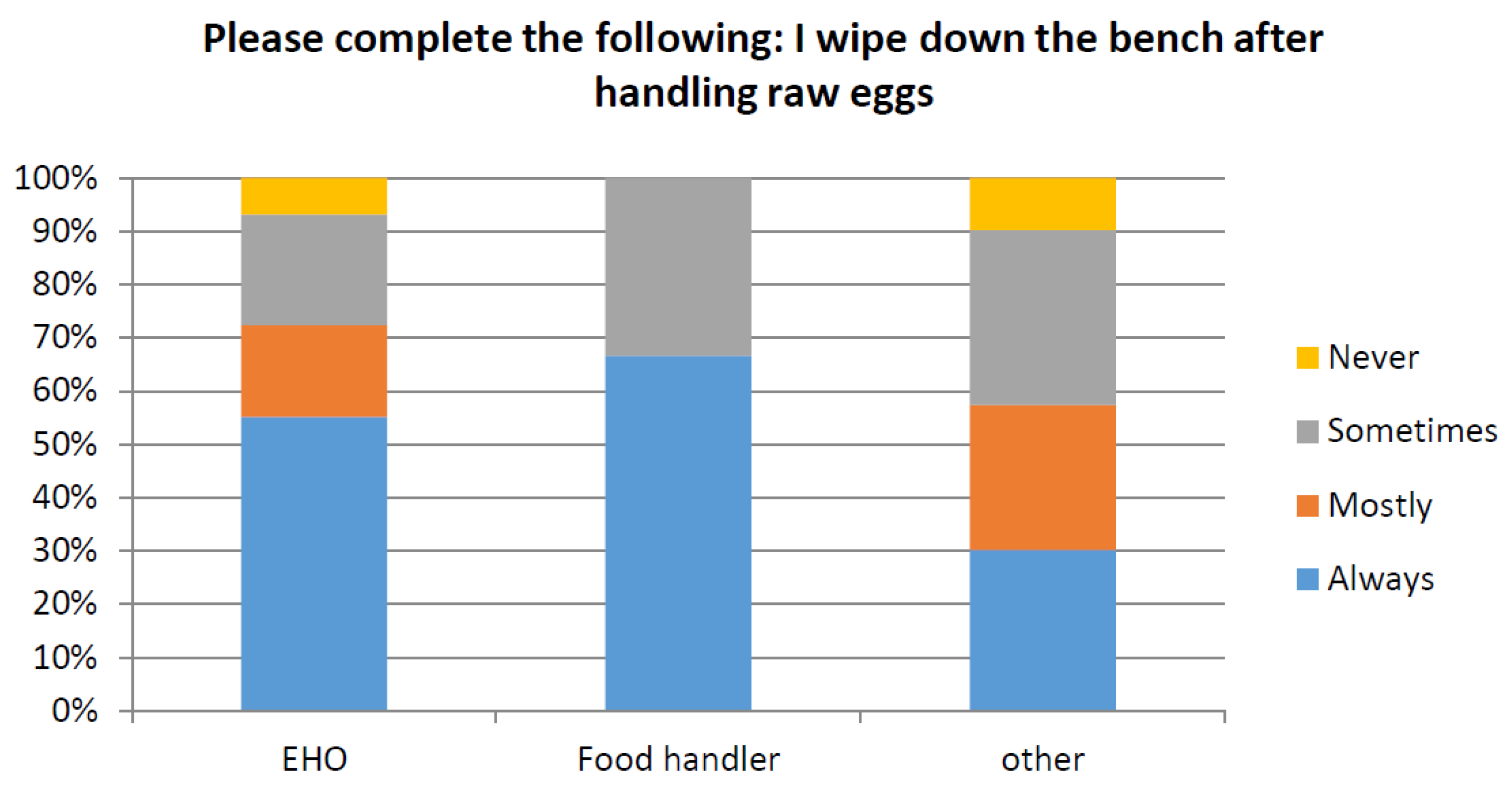
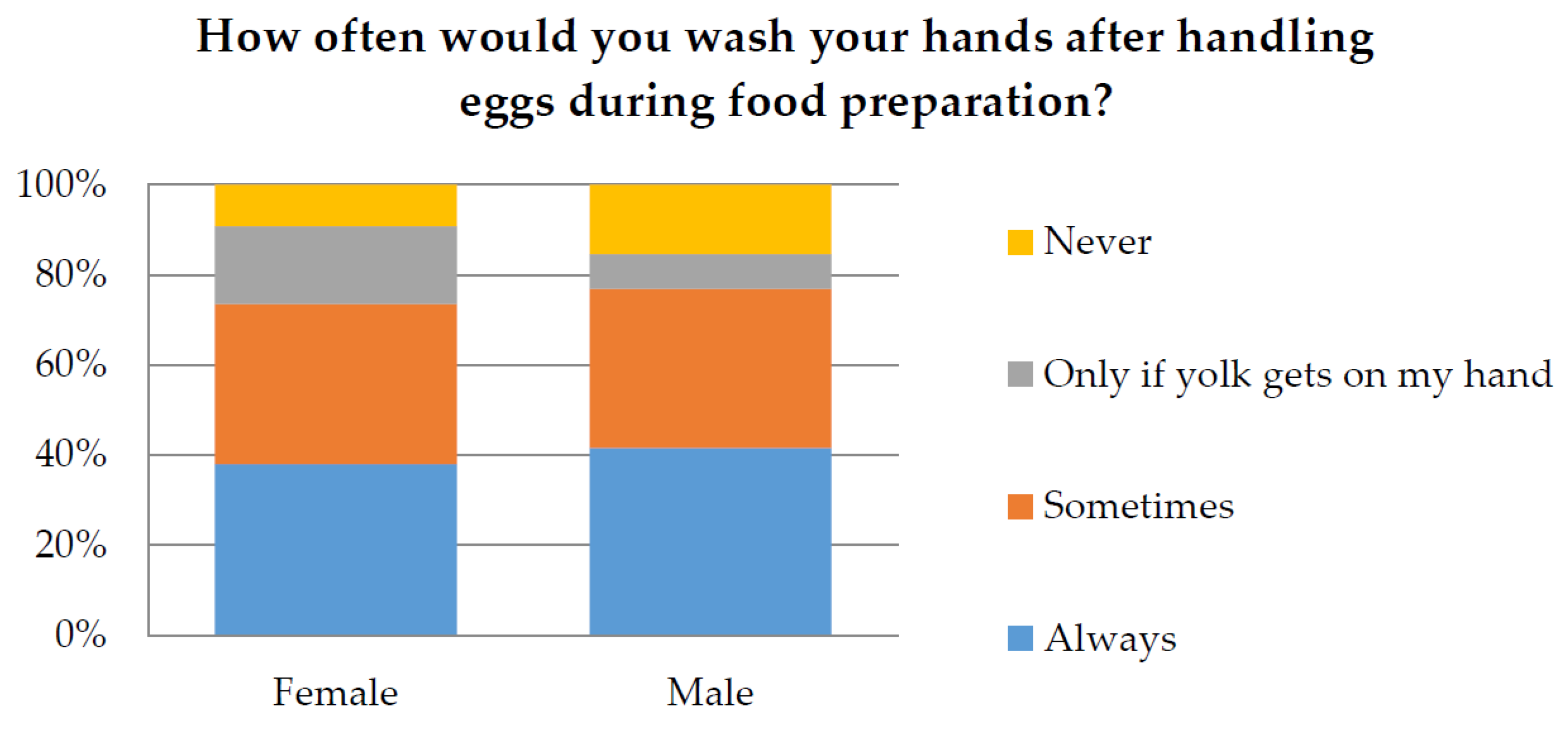
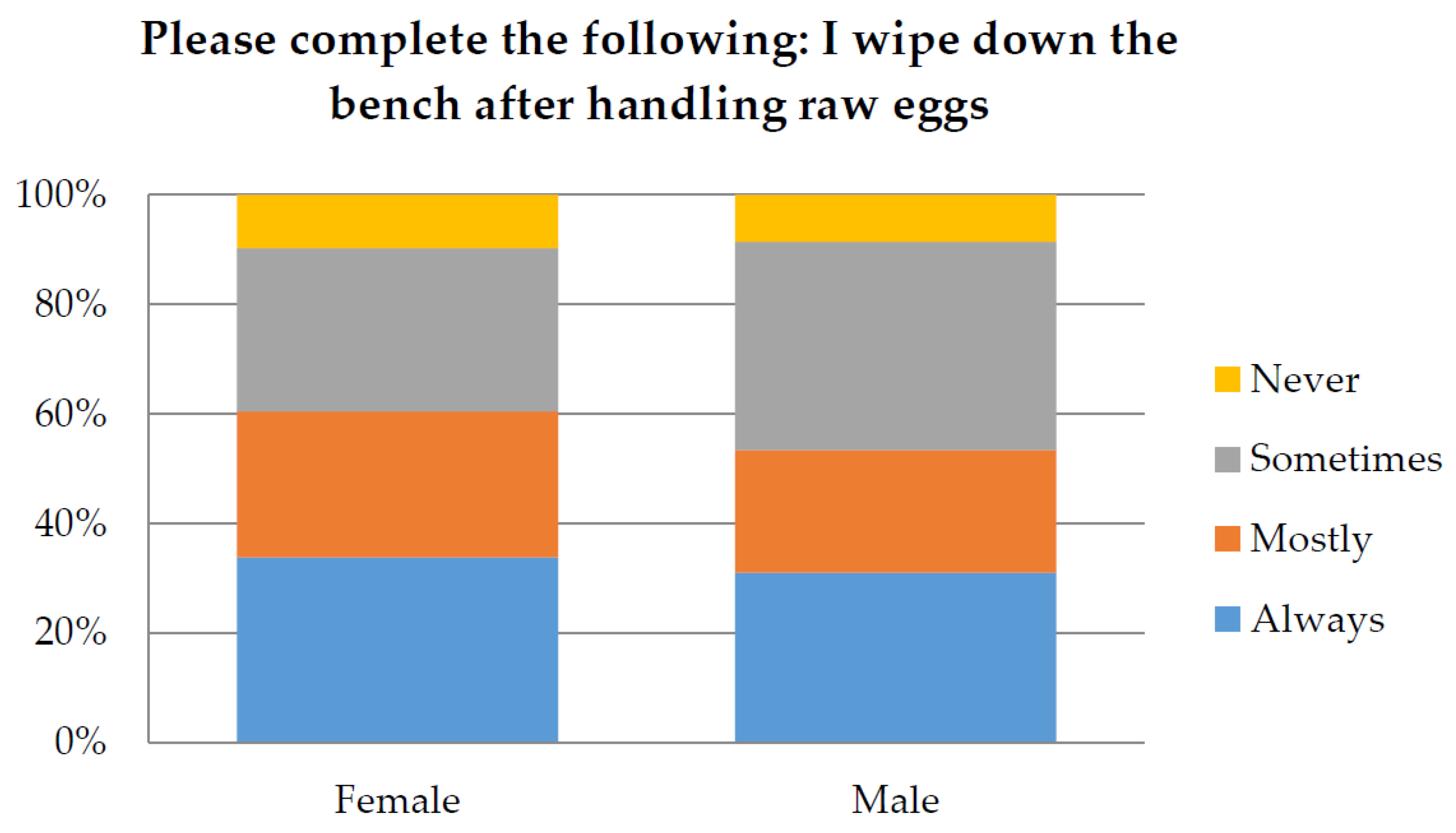
| Characteristics | No. of Participants (%) | |
|---|---|---|
| Gender | Male | 65 (23.0%) |
| Female | 216 (76.6%) | |
| Other | 1 (0.4%) | |
| Age | 25 or under | 48 (17%) |
| 26–35 | 67 (23.8%) | |
| 36–45 | 55 (19.5%) | |
| 46–55 | 78 (27.7%) | |
| 56–65 | 30 (10.6%) | |
| Over 65 | 4 (1.4%) | |
| Highest level of education completed | Less than Year 12 or equivalent | 18 (6.4%) |
| Year 12 or equivalent | 35 (12.4%) | |
| Vocational Qualification | 41 (14.5%) | |
| Undergraduate Diploma | 140 (49.6%) | |
| Master’s Degree | 41 (14.5%) | |
| Doctorate | 7 (2.5%) * | |
| Employment | Environmental Health Officer (EHO) | 29 (10.3%) |
| Food Handler | 9 (3.2%) | |
| Other | 244 (86.5%) | |
© 2017 by the authors; licensee MDPI, Basel, Switzerland. This article is an open access article distributed under the terms and conditions of the Creative Commons Attribution (CC-BY) license (http://creativecommons.org/licenses/by/4.0/).
Share and Cite
Whiley, H.; Clarke, B.; Ross, K. Knowledge and Attitudes towards Handling Eggs in the Home: An Unexplored Food Safety Issue? Int. J. Environ. Res. Public Health 2017, 14, 48. https://doi.org/10.3390/ijerph14010048
Whiley H, Clarke B, Ross K. Knowledge and Attitudes towards Handling Eggs in the Home: An Unexplored Food Safety Issue? International Journal of Environmental Research and Public Health. 2017; 14(1):48. https://doi.org/10.3390/ijerph14010048
Chicago/Turabian StyleWhiley, Harriet, Beverley Clarke, and Kirstin Ross. 2017. "Knowledge and Attitudes towards Handling Eggs in the Home: An Unexplored Food Safety Issue?" International Journal of Environmental Research and Public Health 14, no. 1: 48. https://doi.org/10.3390/ijerph14010048
APA StyleWhiley, H., Clarke, B., & Ross, K. (2017). Knowledge and Attitudes towards Handling Eggs in the Home: An Unexplored Food Safety Issue? International Journal of Environmental Research and Public Health, 14(1), 48. https://doi.org/10.3390/ijerph14010048







